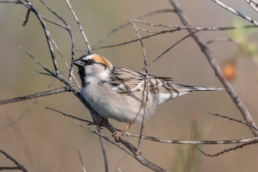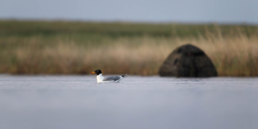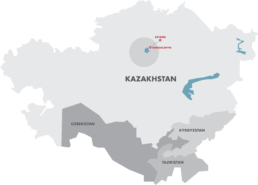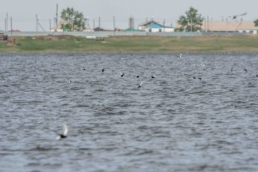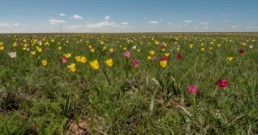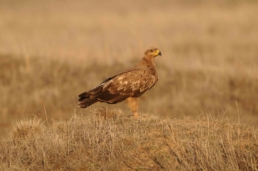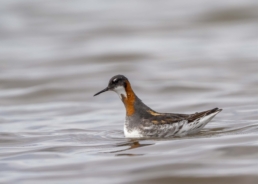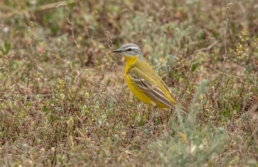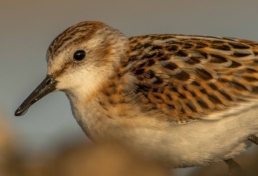Your Kazakhstan itinerary
Day 1: To Astana
Clients depart from home towards the capitol of Kazakhstan, Astana. There are several options, but they best come via Istanbul (Turkish Airlines). If you like to come in earlier, don’t hesitate to contact the RBT office, which will gladly help with additional hotel bookings.
Night: Day 1, on aircraft
Day 2: Arrival and drive to Korgalzhyn
Even though it’s an early start at the airport, the excitement is palpable as we embark on this unique adventure. After a quick cup of coffee and a chance to exchange or withdraw some Kazakh tenge, we board our bus and set off towards Korgalzhyn. The two-hour drive offers time for conversation or a bit of rest. As the sun begins to rise, we arrive at the village that will be our home base for the week. A warm, hearty breakfast awaits us, followed by a chance to check in at our accommodation and catch up on some sleep.
We wake around noon, refreshed and ready for a delicious lunch. Then, it’s time to head into the field for our first scouting mission. We explore the three main lakes where we’ll be photographing and surveying the surrounding steppe, identifying the most promising spots. The air is alive with the sights and sounds of clouds of Ruffs and Western Yellow Wagtails, while Black Larks sing from the nearby grasses. We take some initial shots from the shore, capturing the beauty of the landscape. As evening falls, we return to the village for dinner and prepare our floating hides, ensuring everything is ready for an early start the next day.
Night: Basic guesthouse Korgalzhyn
Day 3 - 7: Photography in Korgalzhyn
Over the next five days, we will fully immerse ourselves in the rich birdlife of the Korgalzhyn region. Our days begin early, driving out to the lakes while it’s still dark to set up our floating hides. By 5:30 a.m., as the sun begins to rise, we are in position and ready to capture the stunning morning light. On the sandy shores, Temminck’s Stints put on a lively display, darting after each other between meals. Above the Tern Pond, the mesmerizing flight of White-winged Terns tests our skills as they snatch insects from the water’s surface mid-air. The sheer abundance of birds, combined with their apparent lack of fear, provides endless opportunities to experiment with our photography, allowing us to perfect our shots within minutes.
As the sun climbs higher and the light becomes harsh, we retreat from the water, returning to Korgalzhyn for a well-deserved breakfast and a brief nap. After lunch, we head back to the steppe, where the evening light creates ideal conditions for photographing the graceful Marsh Sandpipers wading through shallow waters. Positioning our hides near the shore, we can capture stunning images with beautifully blurred backgrounds. As the sun dips below the horizon, it’s the perfect moment to focus on the elusive Pallas’s Gulls, which become more active and less wary, concentrating on catching insects from the water. We wrap up the day with a packed dinner in the field before heading back to our guesthouse for a well-earned rest, ready to do it all again the next day.
Night: Basic guesthouse Korgalzhyn
Day 8: Return to Astana
On our final early morning, we return to the lakes for one last opportunity to capture any species we’ve yet to photograph, or simply to soak in the vibrant steppe scenery one last time. The bushes near the village may reveal Common Cuckoos, Oriental Turtle Doves, or the charming Booted Warbler, whose fluttery song adds to the morning ambience. While Pied Avocets and Greater Flamingos are typically shy, we hope they might decide to grace us with a display, celebrating a successful photography tour in Kazakhstan.
After our morning shoot, we head back to the village for lunch, where we pack our gear and prepare for our departure to Astana. Once there, we take some time to admire the striking futuristic architecture of the Kazakh capital, particularly around the iconic Baiterek monument. We conclude our adventure with a delicious farewell dinner at our hotel, reflecting on the incredible experiences we’ve shared. As we depart in the middle of the night, we leave with our hearts full of memories and our memory cards brimming with stunning images.
Night: Comfortable tourist hotel in Astana
Day 9: Return to home
Early this morning, a transfer will be arranged to Nursultan Nazarbayev International Airport (NQZ), ensuring timely arrival for the Turkish Airlines flight to Istanbul, currently scheduled for departure at 3:20 a.m.
Night: No lodging
Tour information
Focus
- Birds
- Photography
- Mammals
- Vast unique landscapes
Group size
Min 4 - Max 6
The group will always be led by one birding leader and one assistant.
What's included in the Price?
All transport. All accommodations in twin rooming. All meals. All permits and national park entrances. The floating hides and low angle hides of Hoki. Please note: Drinks, tips, possible visas and items of a personal nature including travel insurance, are not included. Clients will need to bring their own waders or drysuit, thermal underwear and beanie-gloves-scarf.
Accomodation
Throughout the tour, we will stay in a basic guesthouse located in the village of Korgalzhyn. This accommodation, while basic, offers an authentic experience of Kazakh hospitality, with warm and welcoming hosts who prepare tasty local meals that showcase the simple flavors of the region. Please note that the rooms are simple yet comfortable, with shared bathroom facilities, reflecting the traditional and communal living style of the area. Despite the modest amenities, the unique experience of staying in a local guesthouse allows you to immerse yourself in the culture and daily life of this fascinating region, making your stay both memorable and enriching.
Difficulty
The tour is designed for fanatical photographers who take their hobby seriously.
Camera gear
We advise clients to bring ne Telephoto lens, minimum 400mm, a Wide-angle lens (optional), Teleconverters, and Tripod or monopod, according to taste, and head for low-angle situations, we recommend a tripod that can spread flat, a ground pod or a bean bag to get as low as possible.
Flights
International flights are not included in the pricing. Please connect with the RBT office to find out your best connection to Central Asia.
Clothing - What to pack?
As we journey through Central Asia’s diverse landscapes, it’s important to pack a versatile wardrobe that can handle the varying climates and activities. For the hot steppe and desert regions, lightweight, easily washable, and quick-drying clothes are essential, along with a wide-brimmed sun hat and sunglasses for sun protection. Mornings can be chilly, especially with the wind, so be sure to bring lightweight but warm layers, including a warm hat, fleece, and light gloves. A light waterproof jacket is recommended for unexpected rain showers, keeping you dry and comfortable.
For footwear, choose light yet sturdy walking boots suitable for the diverse terrains we’ll encounter. Additionally, for our time spent in and around water, thermal clothing is necessary to stay warm during extended periods. Don’t forget to bring waders or a dry suit to ensure you remain comfortable and protected in colder conditions.
Situations
Our working location, in the buffer zone of Korgalzhyn State Reserve, is ideally located to offer a variety of photography situations. We have three main lakes nearby, each different in terms of habitat and thus bird species.
Flamingo Lake is very shallow. It is also quite sheltered from the wind, which means the surface will remain flat like a mirror even when the other lakes are troubled by waves. The iconic species here is the Greater Flamingo, but it’s a shy one. More accommodating are the Common Shelduck, the Little Stint, the Curlew Sandpiper, the Terek Sandpiper, the Dunlin and the Red-necked Phalarope. Because Flamingo Lake is so shallow, it’s very complicated to tread with a floating hide. We prefer to lie down on the shore, either in a hide or under a camouflage net, and let the birds come to us.
The Grebe Lake is the largest in the area, and also the deepest. It’s the realm of Black-necked Grebes, Whooper Swans and Red-necked Phalaropes. The shore attracts many waders, including Black-winged Pratincoles, terns and gulls. The banks have quite a gentle slope underwater, so it’s possible to take the floating hide to the water there. When the wind blows, the waters become choppy; then, the best strategy is often to strand the hide on the shore and wait for birds to come close. On dry ground, a colony of Collared Sand Martins offers more opportunities.
The Tern Pond is smaller but also richer in bird life. It’s a hunting ground for Red-necked Phalaropes, White-winged Terns and Pallas’s Gulls. The sandy and muddy shores attract stints, Ruffs and Marsh Sandpipers, along with Caspian and Gull-billed Terns. The reedbed offers rare but precious possibilities to shoot Paddyfield Warbler and Great Bittern. The creek that leads into the Tern Pond hosts Terek Sandpiper, Red-necked Grebe and Black-tailed Godwit.
The water there is very shallow (rarely more than a meter), making it an ideal location to work with waders in a floating hideThe surrounding steppe areas are also rich with stunning species, such as the common Black Lark or the elegant Pallid Harrier. Western Yellow Wagtails (breeding beema or migrating thunbergi) and Bobak Marmots can also be exciting targets. In this open habitat, we will patiently stand, sit or lie down in a tent or under a camouflage net, to photograph without being seen.
The village offers yet more photography opportunities: there may be Common Cuckoos on migration, Oriental Turtle Doves in the trees, Booted Warblers in the shrubs or Lesser Kestrels breeding in a ruined building.
With so many possibilities, we strive to remain flexible and allow everyone to get a taste of all situations. With a whole week of shooting, we get to choose who does what on a bi-daily basis, as a group. Wildlife photography, and floating hide photography in particular, is an exhausting activity – it’s totally ok to take it easy sometimes, to skip a session or stop early and come back to the bus to rest.
Ready for your next adventure?
Reserve your spot on our Floating Hide photography expedition now
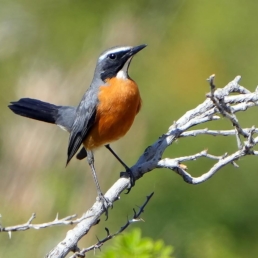
Related tours
Ornithological expedition in the Kazakh Altai
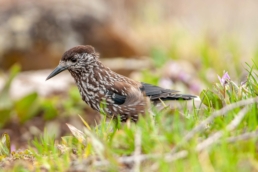
Exciting fall migration in a Palearctic hotspot
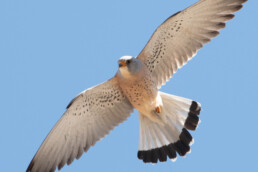
The Flora & Fauna of Altai
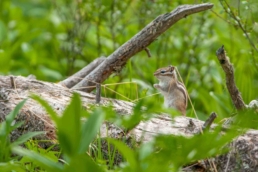
Spring migration in Central Asia
